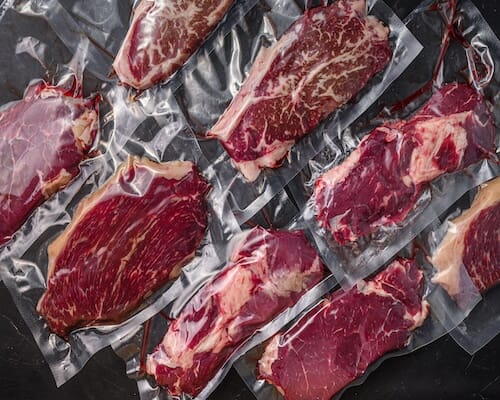
Five Key Applications of Rotary Screw Vacuum Pumps in the Food and Beverage Industry
July 3, 2024
What To Do When Your Air Compressor Is Not Building Pressure
July 17, 2024Keeping Vacuum Costs Down
Kaishan USA | July 10, 2024 | Uncategorized
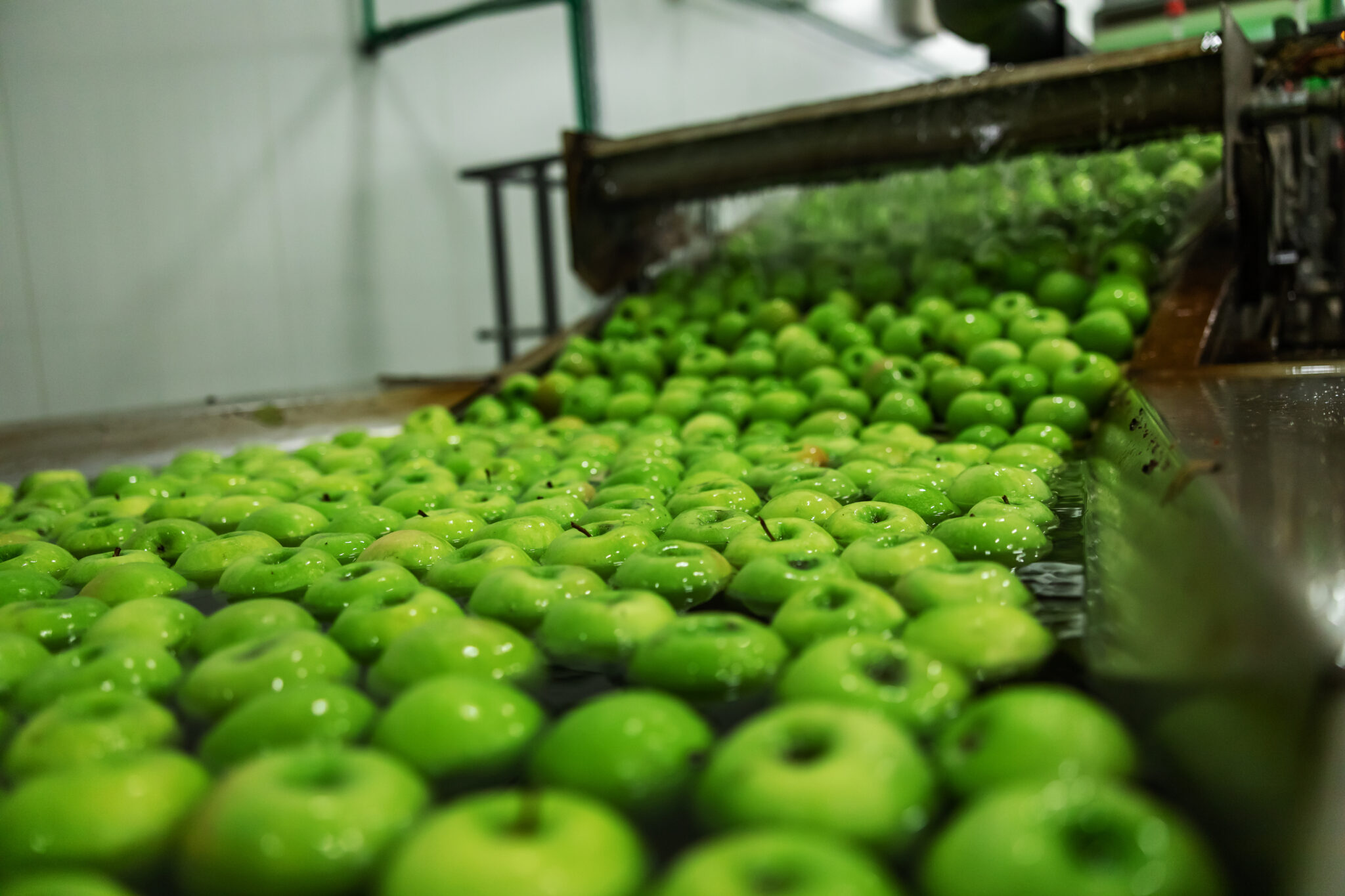
Point-of-use rotary vane vacuum pumps release a fine mist of oil that is a problem in a clean environment such as a food processing facility.
Many industrial plants today find themselves with a fragmented approach to vacuum capability. Some have dozens of small, point-of-use vacuum pumps in their facilities, each attached to a different application. Often built into processing equipment by the manufacturer, rotary vane pumps are the most commonly used.
It’s not unusual for a plant to have several smaller industrial vacuum pumps sitting on a shelf, waiting to be deployed when a pump fails somewhere in the plant. They are almost treated as disposables because rebuilding them could cost between 50% and 70% of the price of buying a new one.
There are some downsides to this approach.
First, companies are finding they constantly have to take a pump out of service and send it for repairs. And changing the oil every 500-1,000 hours gets costly and time-consuming.
And then there’s the downtime involved in both. How long does it take your maintenance staff to swap them out when they break? And, if any (or all) of those pumps will shut down your line, you are looking at a lot of disruption.
Multiply that by the number of applications (and pumps), and you have a significant cost. A service nightmare. And a lot of downtime.
That’s why Kaishan recommends transitioning to a single, centralized vacuum capability outside your production and packaging area.
Benefits of Centralization
Replacing all those individual pumps addresses several issues with the point-of-use approach:
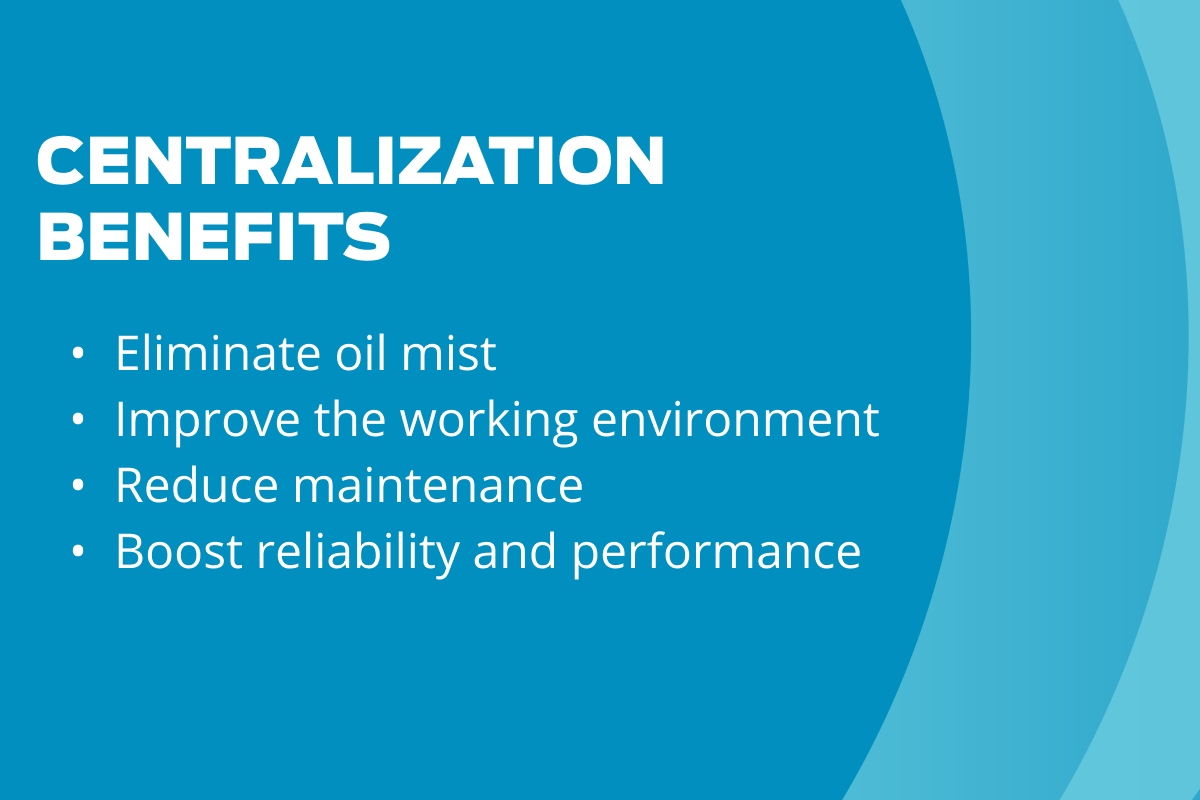
Eliminate Oil Mist in the Production Area
Each of those individual vane pumps releases tiny amounts of oil in aerosol form. That’s unacceptable in a clean or sterile environment, especially an electronics plant or a food and beverage facility.
A centralized vacuum capability would remove that contamination from the production environment.
Improve the Working Environment
In addition to impacting production, the airborne mist impacts your employees. Your workers spend eight hours per day, year in and year out, breathing in that oil mist.
In addition, individual units produce heat, making the factory floor environment even hotter and more unpleasant. Your air conditioning system must also remove that heat.
We’ve also found noise levels drop significantly when the individual vacuum pumps are no longer in service, another safety feature. You’ll want to get these loud machines away from your operators.
Because it is not in the production and packaging area, a centralized system does not present these problems. And helps create a healthier environment for your employees.
Reduce Maintenance
Maintaining one system (and possibly a backup unit) is much more cost-effective than having multiple units scattered throughout your facility. You can schedule maintenance at your convenience, maintaining your pump and backup at planned maintenance intervals.
One pump and a backup will receive more maintenance attention than dozens of pumps scattered throughout the plant. And better-maintained pumps are more reliable.
Boost Reliability and Performance
Many of our customers find that replacing point-of-use pumps pays for itself quickly by eliminating downtime caused by the failure of one or more units. A centralized unit with a planned backup almost eliminates unplanned downtime. Plus, most larger units are equipped with remote connectivity to allow constant monitoring of the machine and its performance.
And, as vane vacuum pumps age, their performance varies. Running several individual vacuum pumps at different levels could lead to pressure imbalances, resulting in leaks and reduced process efficiency. And it could damage the vacuum pumps or the system itself.
The ROI of Centralization
Fortunately, centralizing vacuum capabilities offers an important opportunity to end the maintenance nightmare. Reducing costs. Improving reliability. And putting an end to the whack-a-mole downtime that can sometimes plague plants relying on point-of-use vacuum pumps.
Even more importantly, it results in energy savings, especially when you replace point-of-use pumps with centralized systems, like rotary screw vacuum pumps, that are more efficient energy users. Read more on the benefits of rotary screw vacuum pumps below.
Admittedly, there is an initial investment, especially in connecting the central unit to the various end uses. However, centralized vacuum piping systems are less expensive to create than compressed air systems due to the nature of vacuum vs. pressure within the pipe itself. And vacuum piping systems can utilize lower-cost materials such as PVC.
And the benefits of centralization mentioned above more than pay for themselves in lower costs and higher productivity.
Centralizing your vacuum capability could also qualify for energy rebates.
In addition to eliminating the point-of-use vane pumps currently in use in many plants, we strongly recommend trading up to rotary screw vacuum pumps, which offer many benefits.
Rotary Screw Vacuum Pumps: The Benefits
We recommend using an oil-flooded rotary screw vacuum pump for most rough vacuum applications in traditional manufacturing today.
-
- Low energy consumption. Rotary screw vacuum pumps can be configured to optimize the energy required to perform at various vacuum levels, thereby increasing overall efficiency (see variable speed drive section below).
- Low maintenance costs. A rotary screw vacuum pump will last 20,000 to 30,000 hours before any major maintenance is required, many times the expected life of a rotary vane pump. The lower maintenance costs cut their total cost of ownership significantly.
- Long life. Rotary screw vacuum pumps will last years or even decades with minimal maintenance, like oil changes and oil monitoring. In contrast, the life expectancy of vane vacuum pumps is much shorter.
- Automatic alerts. Today’s best rotary screw vacuum pumps automatically issue alerts when performance falls below a specified threshold. Sophisticated microprocessor controls are constantly monitoring and fine-tuning machine operations to meet your needs and are often capable of notifying the owner via email if there is an issue.
- Low noise. Many rotary screw vacuum pumps are quiet enough to hold a conversation nearby.
In addition to centralizing vacuum capability, we can offer several other ways to keep vacuum costs in check.
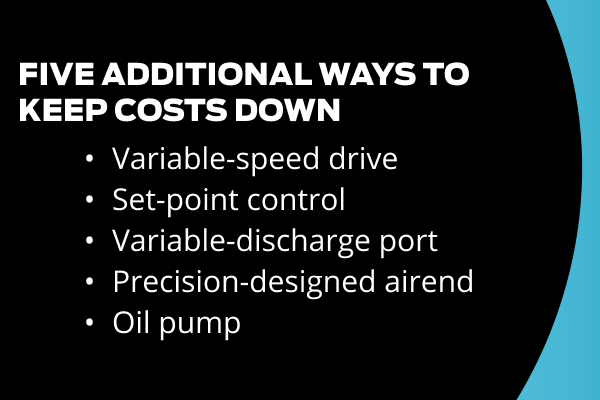
Five Additional Ways to Keep Costs Down
1. Variable-Speed Drive
Make sure your rotary screw vacuum pump is equipped with a variable-speed drive. By adjusting the flow and power consumption to achieve the desired vacuum levels, VSD-enabled industrial vacuum pumps are 30-50% more efficient than a fixed-speed rotary screw vacuum pump or rotary vane pump and 40-60% more efficient than a liquid ring pump.

A variable speed drive allows you to produce the minimum amount of flow required for your process. In this example the process required 1,000 ACFM, and the pump produces 1,343. The VFD can then slow down the pump to only produce the 1,000 required and consume 20% less energy.
2. Set-Point Control
Set-point control combines a vacuum pump’s smart controller with the VSD, allowing you to operate at a pressure setpoint. It turns the vacuum pump up or down based on the demand out there in the plant.

By allowing you to keep the pressure at a constant 22” HgV, set point control saves you energy, by preventing you from drawing a deeper vacuum than is necessary.
3. Variable-Discharge Port
A variable-discharge port increases the volumetric efficiency and performance of a rotary screw vacuum pump. It balances the compression ratio and maintains it in an ideal range, keeping the pump from over-compressing the air and doing work that is not required. As the pressure changes, the port immediately adjusts to ensure maximum efficiency, always maintaining the perfect size. Thus, the compression ratio stays at the optimum level at all pressures.
An industrial vacuum pump with a variable-discharge port and a variable-speed drive will achieve maximum flow and energy savings at any level within its operational range.
A variable-discharge port responds quickly when you start it up, enabling you to achieve a high level of flow for the horsepower consumed. It combines with the variable-speed drive to give you great flow and energy savings at all vacuum levels.
The VSD-variable discharge port combination also adds a level of protection. If the system quickly goes from full vacuum and full demand to ambient pressure levels, a VSD alone will not slow down quickly enough. As a result, the unit would over-amp, causing nuisance alarms or harming the motor. The VSD and variable discharge port combination keeps this scenario from happening.
4. Precision-Designed Airend
You can gain significant efficiencies with a well-designed airend and rotor profile, tight clearances and high-quality bearings.
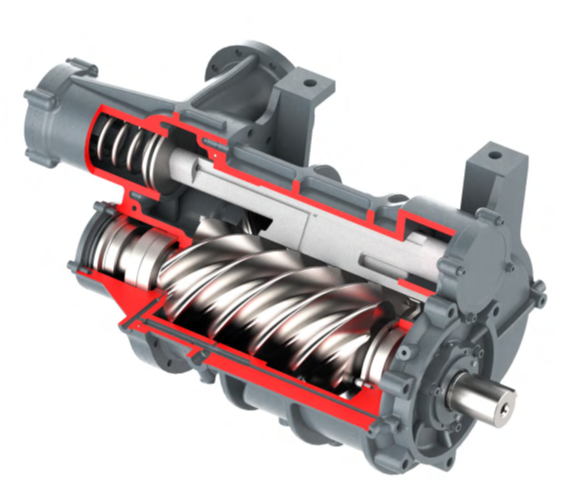
Kaishan’s KRSV rotary screw vacuum pump has an asymmetric 5/6 rotor profile and SKF bearings with a 100,000-hour life expectancy.
5. Oil Pump
Most competitive industrial vacuum pumps rely on differential pressure to provide lubrication. However, if a process requires frequent stops and starts, going quickly from full vacuum and full demand to ambient pressure levels, there is limited differential pressure and, hence, little to no oil flow. So, the pump must start slowly to build up that pressure.
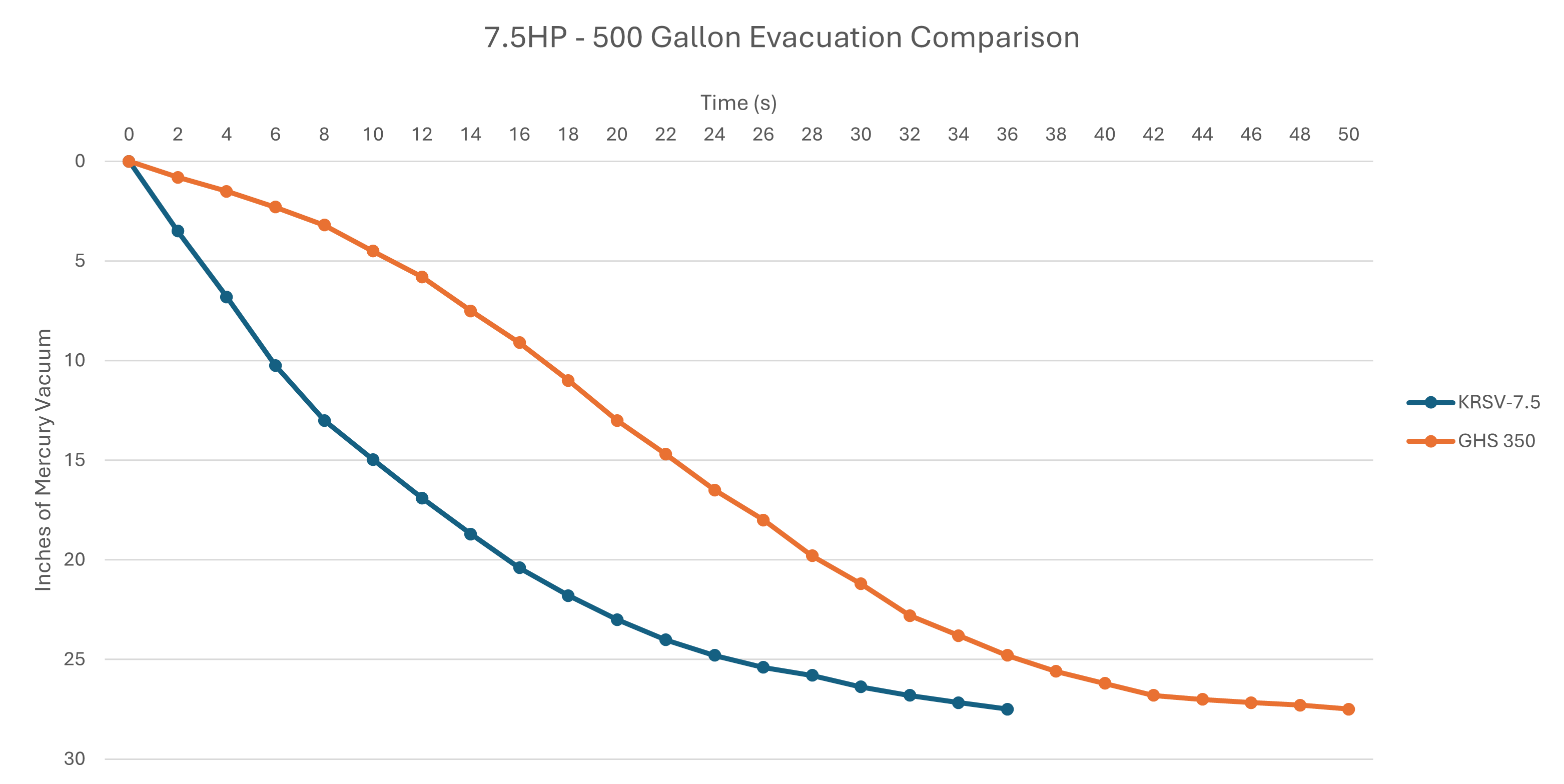
Combining a variable discharge port and an oil pump, the KRSV starts pumping oil immediately, allowing us to ramp up to the maximum speed faster. In this example, a 7.5-HP pump evacuates 500 gallons 28% faster than a competitive pump.
Kaishan’s KRSV: VSD, Variable-Discharge Port and Oil Pump
Kaishan’s KRSV perfectly matches the rough vacuum needs of most industrial plants, reducing maintenance and electrical costs.
KRSV is the only industrial vacuum pump on the market that includes as standard the most advanced features mentioned above—a VSD, set-point control, variable-discharge port, precision-designed air end and external oil pump.
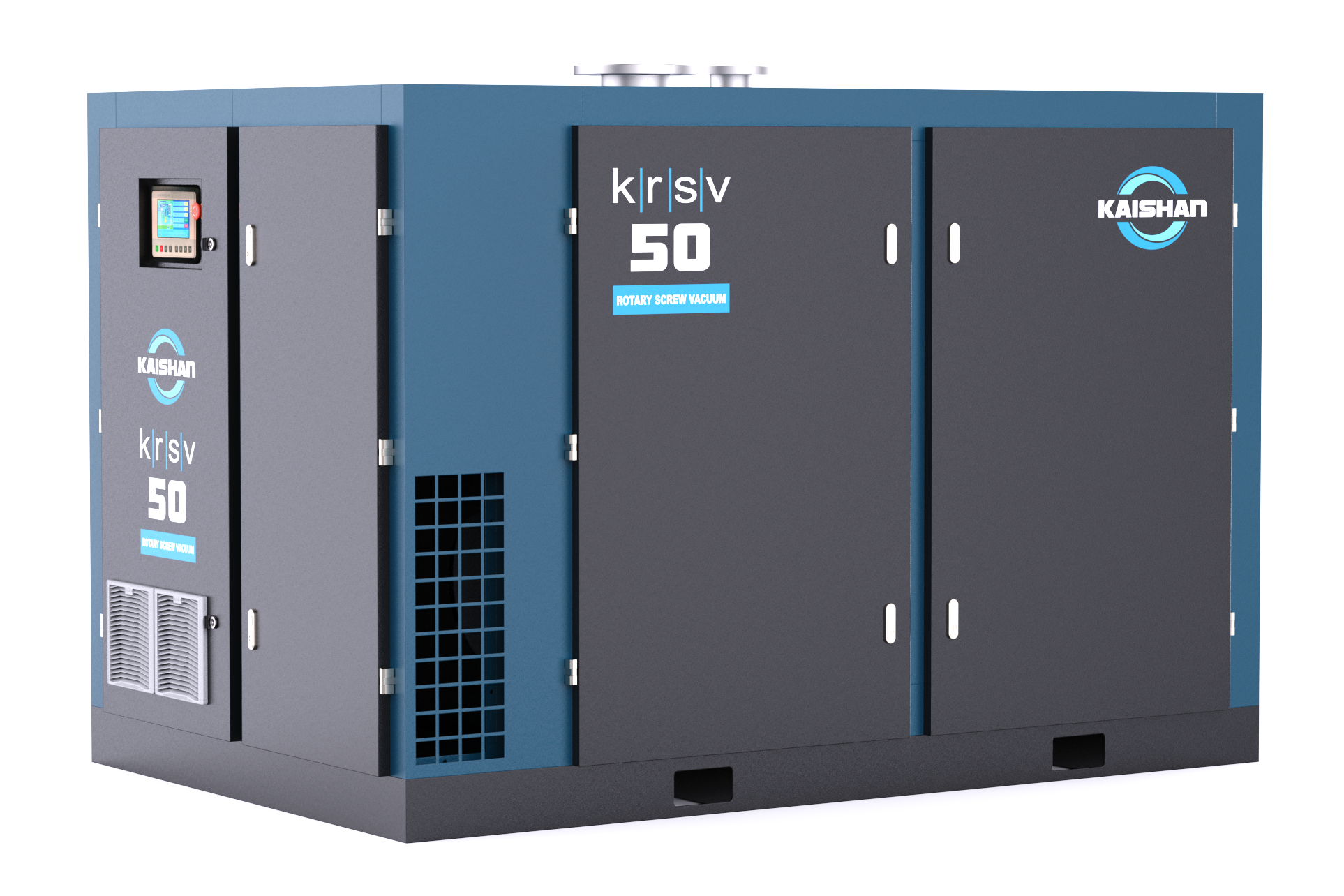
Rotary screw vacuum pumps are known for outstanding reliability and longevity. And our KRSV rotary screw vacuum pump combines a variable-speed drive, set-point control, a variable-discharge port, a precision-engineered airend and an oil pump, making it highly efficient over a wide range of pressures and operating flows.
KRSV’s oil pump begins moving oil on startup, allowing you to ramp up to maximum RPM quickly without the risk that the unit will not have adequate lubrication. As a result, you can begin working almost immediately, saving you time between pieces.
Combining the oil pump—allowing us to ramp up faster—and the variable discharge port—permitting more flow at shallow vacuum levels—enables us to boost productivity significantly. In our tests, we could draw a 500-gallon tank down to vacuum 28% faster than a VSD-only pump could.
Greatest CFM Per Horsepower
KRSV’s design delivers the greatest efficiency in CFM per horsepower—providing the most flow for the horsepower consumed at every vacuum level and thus keeping electricity consumption minimal.
Local Help
We recommend seeking the help of a vacuum technology professional to evaluate your vacuum capabilities and migrate from a fragmented patchwork of point-of-use pumps to a well-designed centralized system. Doing so will pay long-term benefits, cutting costs, reducing maintenance and limiting downtime.
Kaishan USA works with a nationwide network of independent distributors, who can provide on-site help and consultation as needed.
Key Takeaways
-
- Many industrial plants today have dozens of small, point-of-use rotary vane vacuum pumps scattered throughout their plants.
- Facilities with a dispersed vacuum capability will find they can lower costs, cut downtime and reduce maintenance with a centralized industrial vacuum pump.
- Rotary screw vacuum pumps are the best choice to reduce costs, improve reliability, increase efficiency and slash downtime.
- Other ways to reduce energy consumption include variable speed drives, set-point control, variable discharge ports, precision-engineered airends and oil pumps.
- Having a centralized system with primary and back-up units ensures reliability, eliminating the scramble to replace point-of-use units when an issue occurs.
- The KRSV is the only industrial vacuum pump on the market today that includes a VSD, set-point control, variable-discharge port, precision-designed air end and an external oil pump. These all contribute to an efficient, reliable and energy-saving system.
Let Us Help
Centralizing your industrial vacuum pump capability can help reduce costs, improve reliability increase efficiency, and slash downtime. If you need help analyzing your vacuum needs, get in touch with the experts at Kaishan. Contact us today.

